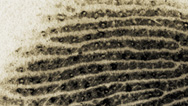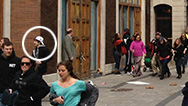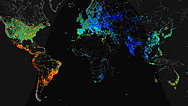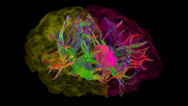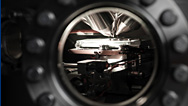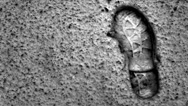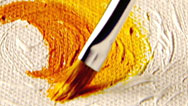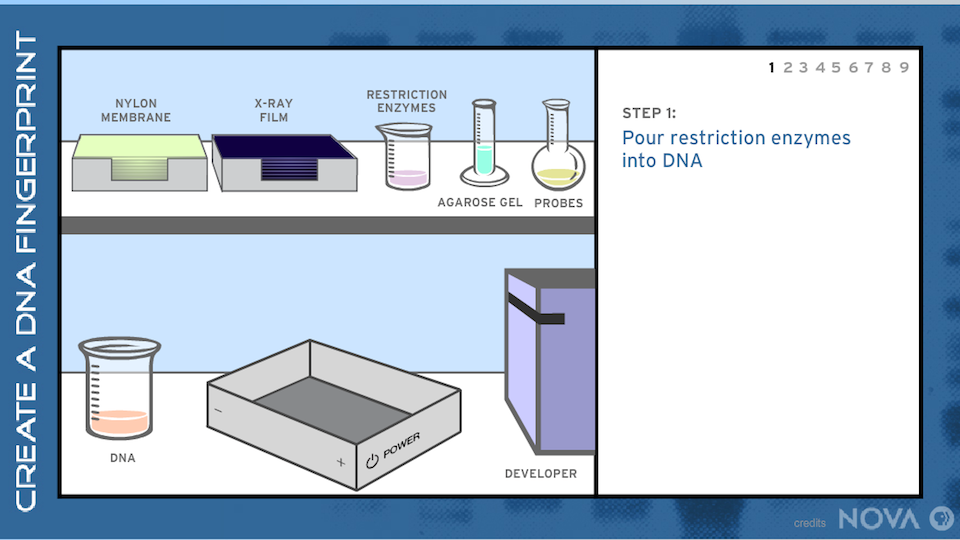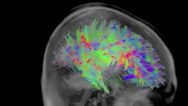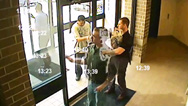
Can Science Stop Crime?
Explore the genetics behind criminal minds, the latest in lie detection, a human corpse "farm," and more. Airing October 17, 2012 at 9 pm on PBS Aired October 17, 2012 on PBS

Program Description
Transcript
Can Science Stop Crime?
PBS Airdate: October 17, 2012
DAVID POGUE: Is there any way science can stop crime?
I'm David Pogue, and on this episode of NOVA scienceNOW, we're tracking down cutting-edge research in the world of crime-fighting.
Are killers born or made?
JAMES FALLON (University of California, Irvine): These stories started to proliferate that there was something really wrong in our family.
DAVID POGUE: Are some people more prone to violence than others? What is the "warrior gene?" And what is its relationship to aggression?
KEVIN BEAVER (Florida State University): There are some men that are, biologically speaking, much more likely to be violent and aggressive than others.
DAVID POGUE: We're peering inside the criminal mind.
JOSHUA BUCKHOLTZ (Harvard University): Environments can change the way that your brain is wired.
DAVID POGUE: And…
Captain, there seems to be a disturbance in the tri delta vector.
With new technology, can we sense lies in the brain before they're even spoken?
JENNIFER VENDEMIA (University of South Carolina): In about 200 more milliseconds, he is going to be ready to lie.
DAVID POGUE: You got to the point where you could know whether I was lying or not?
JENNIFER VENDEMIA: Yes.
DAVID POGUE: That's freaky.
And can scientists help investigators determine when a victim died?
MICHELLE HAMILTON (Texas State University): So timing is really crucial.
DAVID POGUE: How do you even estimate?
PETER CUMMINGS (Commonwealth of Massachusetts Office of the Chief Medical Examiner): Come here. I'll show you.
DAVID POGUE: Isn't this usually reserved for less animated people?
PETER CUMMINGS: Typically.
DAVID POGUE: Their discoveries may shock you.
Three days? But how could that be?
MICHELLE HAMILTON: That's what we're going to try to find out.
DAVID POGUE: Can Science Stop Crime? Up next, on NOVA scienceNOW.
I'm David Pogue, host of NOVA scienceNOW by day, and by night a caped crusader on mission to fight crime. Okay, not really.
I had no idea that getting a perm was such a complex operation these days.
But I am on a mission to find out if science can stop crime.
Is this an eBay hair salon purchase, here?
But this isn't all fun and games. We hear about violence in the news all the time.
NEWS ANNOUNCER (Film Clip): In an especially brutal attack on a teenage…
NEWS ANNOUNCER (Film Clip): He confessed to killing 33 boys.
DAVID POGUE: Now, scientists are trying to find out if there is something different about the criminal mind.
JAMES FALLON: I looked at it, and I said "This is obviously a murderer." But it was me!
DAVID POGUE: Are violent brains created by nature...
There goes my spleen!
...or nurture?
EUGENE JACKSON: Faster, faster, faster. Power both hands, power both hands. Don't stop, don't stop, don't stop.
DAVID POGUE: I'm in San Francisco, learning how to fight. My trainer is a former gang member and mixed martial arts champion, Eugene "The Wolf" Jackson.
EUGENE JACKSON: Don't act like you was an A.P. student.
Good. We got the warm up out of the way.
DAVID POGUE: Jackson teaches teens to stay off the streets by taking their aggressions out in the ring. One of Jackson's most promising fighters is his own son: Nikko.
In the ring, Nikko is a feared fighter, the top of his division after only two years of training.
NIKKO JACKSON (Mixed Martial Arts Fighter): It's me versus you. Who's the better man? Like, only one of us is going to walk out with our hand raised, and I love that.
DAVID POGUE: Oh, my god, that's allowed? Cutting off his blood?
But as a young teen, Nikko's urge to fight got out of control.
NIKKO JACKSON: My first year of high school, I started straying down the wrong path.
DAVID POGUE: He got caught up with the notorious Taliban gang.
NEWS ANNOUNCER (Film Clip): Local, county, state and federal agencies teamed up to target these violent gang members they say are responsible for murders, assaults, rapes.
DAVID POGUE: We all know people who seem more violent than others, with shorter tempers and less self-control.
What causes aggressive behavior? Is it their upbringing? Is something wrong with their brains? And most controversial of all: could violence be in their genes?
There's obviously some aggression on display here.
KEVIN BEAVER: Right.
DAVID POGUE: Criminologist Kevin Beaver analyzed the genetic profiles of more than 1,000 young men and examined their criminal records and says he found a pattern.
KEVIN BEAVER: There are some men that are, biologically and genetically speaking, much more likely to be predisposed to be violent and aggressive than others.
DAVID POGUE: If that's true, is it possible that Nikko is one of them?
Nikko's D.N.A. has been analyzed, and he carries a controversial gene that, according to some reports, has been linked to violence.
It's been nicknamed the "warrior gene."
NIKKO JACKSON: I try to avoid problems as much as possible, but I have a limit, when reached, that I just flip out, redline a little bit.
DAVID POGUE: Is it really possible for one gene to have that kind of impact?
It turns out the so-called warrior gene is actually one version of a very important gene called "MAOA."
The gene works in the brain, helping to control chemicals called neurotransmitters that allow brain cells to communicate with each other.
KEVIN BEAVER: What that gene is responsible for doing is regulating levels of neurotransmitters. And these chemicals are responsible for our behaviors and our traits and things of that nature.
DAVID POGUE: All of us have the MAOA genes, but about a third of men carry a version that's less active and may leave more neurotransmitters floating around in our brains.
So, what's the result?
Well, we know what happens in mice.
Scientists at the University of Southern California engineered these mice to have a totally dysfunctional version of the gene, and their personalities are obviously transformed.
JOSHUA BUCKHOLTZ: When you do this in mice, you see that they become incredibly aggressive. These are the mice who are much more prone to biting and scratching and attacking.
Very straightforward, very simple test…
DAVID POGUE: But what happens in people?
Neuroscientist Joshua Buckholtz is one of the researchers now trying to unravel the relationship between this gene and violent behavior. He's found evidence that it can affect some key circuitry for emotion and learning in our brains.
JOSHUA BUCKHOLTZ: Let me tell you a story.
DAVID POGUE: To understand how this circuitry is supposed to work, Buckholtz told me a little story.
JOSHUA BUCKHOLTZ: Imagine that you're walking through the forest one day, and you look down and you see a snake.
DAVID POGUE: Snake, snaaaaake!
At that moment, a part of my brain that's primed to detect threats, called the amygdala, starts firing on all cylinders.
JOSHUA BUCKHOLTZ: The amygdala is like an alarm bell. It's really important for telling the rest of your body that something important is happening in the world, and you need to prepare for it. And your heart starts beating, and your pulse starts racing. You start sweating.
DAVID POGUE: But just as I'm starting to freak out, I take a closer look.
JOSHUA BUCKHOLTZ: And then you look down again, and you see that it's not a snake. It's actually a stick. And you feel your heart start calming down and your pulse isn't racing so much.
When you get some new information, you update.
DAVID POGUE: I'm able to update, because a learning part of my brain, in the prefrontal cortex, sends a message to my amygdala to shut off the alarm.
JOSHUA BUCKHOLTZ: And that sends input back down to the amygdala that says, "Cool it. Relax. We're okay." And you don't even feel anxious any more.
DAVID POGUE: At least, that's what's supposed to happen.
JOSHUA BUCKHOLTZ: Let's get you into the scanner.
DAVID POGUE: But when Buckholtz looked at the brains of people with the controversial version of MAOA, this part of the brain looked different.
JOSHUA BUCKHOLTZ: What we found was that the people show less grey matter in parts of the brain that are involved in this circuit we've been talking about.
DAVID POGUE: They have less grey matter?
JOSHUA BUCKHOLTZ: That's right. They have less grey matter than the people who have the, the other version of the gene.
DAVID POGUE: Not only did they have less grey matter, but when they were processing emotions, Buckholtz found their amygdalas were more active. So would that make them violent?
JOSHUA BUCKHOLTZ: Well, no, I mean this is the really interesting thing. All of these people who we brought into our lab are just normal community volunteers. These are not violent people. These are not psychopaths. These are not criminals.
And what that tells us is that that one single factor, acting alone, isn't enough to make someone violent.
DAVID POGUE: So even though about one third of men, including Nikko, have the so-called warrior gene, that doesn't make them aggressive.
The creation of a truly dangerous mind is far more mysterious than a single gene. D.N.A. is just one piece of the puzzle.
Oh, there goes my spleen.
So what are the other pieces? Few people have pondered this mystery more than neuroscientist James Fallon. Fallon has spent more than a decade studying the brains of violent killers, but a few years ago, his work took an unexpectedly personal turn, when he discovered that his own family has a lot of blood on its hands.
JAMES FALLON: These stories started to proliferate that there was something really wrong in our family.
DAVID POGUE: The Fallon clan includes nearly a dozen murderers, spanning more than three centuries. Suspected ax-killer Lizzie Borden was a cousin.
JAMES FALLON: That's not cheating its gamesmanning.
DAVID POGUE: Curious, Fallon had his immediate family tested for the so-called warrior gene, and it turns out that he, his mother, his wife and their son, James, all have it.
Next, Fallon investigated a collection of brain scans he'd gathered while working as a consultant on criminal trials. Compared to non-criminal brains, the murderers' scans appeared to show abnormal circuitry in the emotional part of the brain.
When Fallon had his own brain scanned, the result shocked him.
JAMES FALLON: I looked at it, and I said, "This is in the wrong pile; it's obviously a murderer." But it was me!
DAVID POGUE: Of course, it's actually impossible to I.D. a murderer based on a single scan, but Fallon saw a pattern of activity that suggested that he had the same unusual brain wiring as the criminals.
JAMES FALLON: It was disorienting, but it was like, "Oh, I got the joke; the joke is on me. I've been studying this stuff, and I got the pattern."
DAVID POGUE: Still, Fallon might be an aggressive Scrabble® player, but he is not violent. The question is, why not?
Fallon, himself, believes he was biologically at high-risk for a violent life, but that those negative factors were trumped by an overwhelmingly positive childhood.
JAMES FALLON: I was really loved—like a golden child—and it must have just negated the effect of all these other violence-related genes and everything.
DAVID POGUE: But could environment really counteract the negative effects of high-risk genes and brain structure? And what really goes on in a violent mind?
Scientists at Brookhaven National Laboratory are trying to answer just these kinds of questions, by investigating explosive, violent personalities, compared with calmer folks. And I've signed up to be one of their crash test dummies.
Do you have this in a 44-long?
Scientists here are doing comprehensive studies, on hundreds of volunteers.
300!
PATRICIA WOICIK (Brookhaven National Laboratory): Oh, sorry.
DAVID POGUE: Thanks a lot.
They run a battery of tests, analyzing personalities, genetics and family histories.
GENE-JACK WANG (Brookhaven National Laboratory): Before we start, can you hold my brain?
DAVID POGUE: They're trying to discover how these factors and our environment may impact aggression.
I get the third degree in a behavioral analysis called the Buss-Perry Aggression Questionnaire.
PATRICIA WOICIK: What we're going to do is use a scale from one to five.
DAVID POGUE: That's a fancy name for asking really personal questions.
Okay.
PATRICIA WOICIK: People often joke about me when I'm not around?
DAVID POGUE: Two.
PATRICIA WOICIK: Sometimes I'm so envious…?
I typically don't agree with others…?
DAVID POGUE: One. Three.
PATRICIA WOICIK: I have no problems letting my friends know…?
Suddenly I get very mad, but it only lasts…
DAVID POGUE: One.
PATRICIA WOICIK: I often feel like a pressure cooker, pressure cooker, pressure cooker…
DAVID POGUE: Why do you people always ask me this?!
Luckily, my results show my aggression levels are normal.
But sifting through hundreds of profiles, lead investigator Nelly Alia-Klein looks for clues to what causes some people to have hair-trigger tempers.
Is there a scale? Is there a Richter scale for anger? Are there specific medical terms for these different degrees?
NELLY ALIA-KLEIN (Brookhaven National Laboratory): There are people who intermittently explode. They feel anger on a regular basis, and then, when there is a confluence of events that provoke them in certain ways, then they lose control, and they explode.
DAVID POGUE: Nelly Alia-Klein says this extreme form of anger that we sometimes see on the news is called "intermittent explosive disorder," or I.E.D. It's estimated to affect as many as 16 million Americans, and, incredibly, Alia-Klein can see how I.E.D. affects the brains of her test volunteers.
She uses PET scans, or Positron Emission Tomography, to measure activity levels in different parts of the brain.
With these scans she compares the average activity for two groups: people with high levels of aggression, including I.E.D., on the right, and those with low aggression on the left.
NELLY ALIA-KLEIN: We call these blobs. And what they tell us…
DAVID POGUE: That's the technical term?
NELLY ALIA-KLEIN: Yes.
DAVID POGUE: Blobs.
NELLY ALIA-KLEIN: And what they tell us is that's where the activity, the brain activity, is happening, in these specific regions of the brain.
DAVID POGUE: The more violent brains have big yellow blobs, showing increased activity in areas, including the premotor cortex, which helps control movement. This area often lights up when we're anxious and perceiving a threat, so we can get ready for action. What's surprising is that the brains of highly aggressive people appear raring to go, even when they are not doing anything.
NELLY ALIA-KLEIN: This is at rest. This is when nobody is bothering them, nobody is provoking them.
DAVID POGUE: Wait, so they have this much activity in their brain, at rest?
NELLY ALIA-KLEIN: Just at rest.
Their brain is more ready for action than the brains of these individuals, the non-aggressive ones.
DAVID POGUE: Well, no kidding. Their brains are going nuts, even when they're just lying there in a tube.
Alia-Klein's research reveals that people with intermittent explosive disorder may perceive threats, when there really are none.
So these folks with violent brains all have the so-called warrior gene? No! Once again, the gene and violence did not go hand in hand. So what else could be influencing these brains?
Some studies indicate that, in addition to genes, environmental factors, like an abusive childhood, can play a critical role in shaping the developing brain.
JOSHUA BUCKHOLTZ: One of the things that we know about environments is that environments, too, can change the way that your brain is wired, can change brain structure.
NELLY ALIA-KLEIN: The environment feeds the brain in such a way that it actually changes the brain.
DAVID POGUE: And one of the areas that can be changed by environment is the circuitry involving emotion.
JOSHUA BUCKHOLTZ: When you have multiple factors interacting, when you have genes that affect this brain circuit, when you have environmental influences that affect this circuit, but also thousands of other genes and thousands of other proteins in the human brain, those factors, together, are what push people over and, and are likely to cause them to be violent.
DAVID POGUE: There's also some encouraging news: evidence suggesting that a positive environment may help counteract negative risk factors.
NELLY ALIA-KLEIN: A positive environment can, sort of, change the picture, change the future, in a way.
DAVID POGUE: Research, so far, shows that it most often takes genetic and environmental factors to make a violent mind.
KEVIN BEAVER: What we see is that, in people with a certain genetic predisposition for violence or crime, that predisposition may never surface in the face of a positive environment that is able to dampen or mute the genetic effect.
DAVID POGUE: We can't control our genes, but environments can be changed, and that may make a difference.
My next stop takes me on one of my most disturbing missions, ever. I'm at a special research site at Texas State University, where scientists study what happens to human bodies after they die.
Tell me again why you put dead human bodies in this field?
MICHELLE HAMILTON: Well, we're really interested in asking questions about time-since-death, decomposition. And the best way to do that is to actually simulate a crime scene or a death scene, so that's what we're doing.
We need to be careful where we step. There are rattlesnakes out here.
DAVID POGUE: Oh, great. Now we've got rattlesnakes.
MICHELLE HAMILTON: This is Texas.
So, there are different kinds of research strategies.
DAVID POGUE: Forensic anthropologist Michelle Hamilton and her team have laid out the remains of people who donated their bodies to help solve some big mysteries: How do different environments affect and alter decomposition? And when confronted with a corpse, how accurately can we determine when someone died?
Here's something.
Oh, my gosh. Please don't tell me that's hair.
MICHELLE HAMILTON: That's hair.
DAVID POGUE: Wow. Is this a he or a she?
MICHELLE HAMILTON: This is a she.
DAVID POGUE: And you know that because you guys put her out here?
MICHELLE HAMILTON: Right.
DAVID POGUE: She donated her body, and you placed her here?
MICHELLE HAMILTON: Exactly.
So how long do you think the skeleton has been out here?
DAVID POGUE: Oh, nine months, a year?
MICHELLE HAMILTON: You know, I think six months to a year is a good guess when you see a skeleton in this state, but it's wrong. This individual, three days ago, was fully fleshed.
DAVID POGUE: Three days? But how could that be? This thing is bleached, dry bones and scattered all around. There's nothing left.
MICHELLE HAMILTON: Well, that's what we're going to try to find out.
DAVID POGUE: In a real crime, my mistake could be critical.
MICHELLE HAMILTON: Knowing how long it is that a body has been out and decomposing, will help us for things like putting a perpetrator at a scene, so timing is really crucial.
KATE SPRADLEY (Texas State University): They may have an alibi for a specific time, and if our time-of-death estimate is wrong, then that person may never get caught.
Film Clip: I tentatively place the time of death at two to four months ago.
DAVID POGUE: But with the stakes so high, how do experts actually estimate time-since-death?
Film Clip: She died within the last 12 hours.
DAVID POGUE: On TV, they always make it look so easy!
Film Clip: I estimate time of death at or around four days.
DAVID POGUE: To find out how it really works, I'm visiting the Massachusetts Office…
Oh, wow.
…of the Chief Medical Examiner, the state morgue.
What goes on in here?
PETER CUMMINGS: This is the autopsy suite, and this is where we do all our postmortem examinations.
DAVID POGUE: Forensic pathologist Peter Cummings performs about 300 autopsies a year, including cases with suspicious circumstances.
PETER CUMMINGS: This is a typical autopsy station.
DAVID POGUE: In addition to finding the cause of death, it's his job to determine when a person died.
Now, I'm not a forensic pathologist, but I've seen one on TV. And I know that they always go, "Your Honor, the time of death was 10:43."
So, how do they know so precisely when somebody died?
PETER CUMMINGS: Good writers?
DAVID POGUE: You mean that's not based on reality?
PETER CUMMINGS: Uh, no. I wish, I wish we could do that. The majority of my death certificates, unfortunately, I have to put "unknown" for time of death, because I don't know.
DAVID POGUE: What do you mean you don't know?
PETER CUMMINGS: I don't know.
DAVID POGUE: You always know. They always put, "Time of death, 7:22."
PETER CUMMINGS: I wish. We can estimate, but we can't really get an exact time of death.
DAVID POGUE: All right, so how do you even estimate?
PETER CUMMINGS: Come here. I'll show you.
DAVID POGUE: You want me to get up on this thing?
PETER CUMMINGS: Yes, sir. Hop up.
DAVID POGUE: Isn't this usually reserved for less animated people?
PETER CUMMINGS: Typically.
The first thing we'll talk about is rigor mortis.
Put your arms up like this, David.
DAVID POGUE: This is how I died?
PETER CUMMINGS: This is how you died.
DAVID POGUE: I died while I was, you know, using a dousing rod or something?
PETER CUMMINGS: Let's think reading in bed.
DAVID POGUE: Okay, reading in bed.
PETER CUMMINGS: Don't let me move you. Try to resist me, okay?
DAVID POGUE: Okay.
PETER CUMMINGS: So, with rigor, what will happen is your muscles will freeze like this, and I won't be able to move you.
What happens is, with the body, your muscle contractions are dependent upon energy production.
DAVID POGUE: When we're alive, our muscles move through the interaction of two different proteins.
Tiny extensions from one grab and pull on the other, over and over again, to produce movement. But before the proteins can let go of each other, they need an energy boost from a little molecule called A.T.P.
PETER CUMMINGS: So, what'll happen, when you die, you stop producing A.T.P., so your muscles can't relax, and they'll stay in the position that you died in, if you're left there for a long enough period of time.
DAVID POGUE: It takes about three hours after death for the A.T.P. in our muscle cells to get completely used up, and then our muscles begin to lock into place.
PETER CUMMINGS: So if you've just died—put your arms down, and let me—and I'm able to do this to you? If I touch you, and you feel warm, you've probably been dead less than three hours.
And if your body's cold and then flaccid again, and I can move you around really easily, I know you've been dead more than 36 hours.
DAVID POGUE: Wait a minute, rigor mortis goes away?
PETER CUMMINGS: It comes and goes.
DAVID POGUE: Really?! I thought you just got stiff and then that's how you are.
PETER CUMMINGS: No, what happens is your muscles will start to decompose. Just like leaving a piece of steak on a counter, it's going to get brown and mushy; the same thing happens to your muscles. So the actual physical fibers break down, and then your rigor mortis goes away.
DAVID POGUE: And as soon as decomposition really gets going, detecting time of death gets a lot trickier.
The biggest factor in decomposition is the temperature around the body, especially outdoors.
PETER CUMMINGS: Unfortunately, people don't always die in their home, at a nice room temperature. There are people that die outside on hiking trails, or people that die in water. So the environment and where you die and where your body's disposed of can greatly effect how you decompose.
DAVID POGUE: That's where that Texas field with the body comes into play. TV crime shows call it a "body farm."
PETER CUMMINGS: These are fascinating places. They take humans and do all kinds of things to them, to see how they decompose in the environment, what factors affect it, because there are so many things about a decomposed body that can trick you.
DAVID POGUE: Here, at Texas State University, experts like Forensic Anthropologist Kate Spradley investigate the rate, pattern and timelines of human decay.
KATE SPRADLEY: Especially watch your step over here.
DAVID POGUE: They've made some surprising discoveries. For one, bodies in Texas decompose faster in the shade than in the sun.
KATE SPRADLEY: Most of the bodies that we lay out, at our facility, here, in the sun, never fully decompose, they mummify.
DAVID POGUE: You're kidding.
KATE SPRADLEY: And they can do that in about three to four months.
DAVID POGUE: But in the shade, where there's less light, tissue is consumed more quickly, like on this pig carcass.
The culprits come from flies, which land on the body almost immediately and start laying eggs.
JEFF TOMBERLIN (Texas A&M University): So if we come over here and look under the limbs, we might find something here. And, lo and behold, this is all eggs.
DAVID POGUE: Oh, my gosh.
JEFF TOMBERLIN: Literally in the thousands of eggs.
So, in fact, we could probably pull off some eggs here and give you something to look at. So this is all eggs.
You can see they're hatching right now.
DAVID POGUE: Oh, it's moving!
When the eggs hatch, they become maggots.
It's moving!
And by studying the time it takes to develop from egg to maggot to fly, in different environments, investigators can start to estimate time since death.
But how do you estimate time of death, when there's hardly any body at all?
Remember that skeleton I found the other night? I'm told it was a flesh-filled body, just three days ago.
In the light of day, Kate Spradley shows me another skeleton in similar condition.
KATE SPRADLEY: So what you see right here, the mandible, the lower jaw of the individual we used in our study…
DAVID POGUE: Wow.
KATE SPRADLEY: This was where we placed our body donation.
DAVID POGUE: This is where the body was? Where there is nothing now but the lower jaw?
KATE SPRADLEY: Where there is nothing now but the lower jaw.
And then, if you look over here, you can see the bleached white bones, and those are the disarticulated and dispersed skeleton elements.
DAVID POGUE: Incredibly, the bones are now 20 feet from where the body was placed.
What could scatter bones and consume a body so quickly? Spradley had to find out.
KATE SPRADLEY: It was not characteristic of anything that we'd ever seen before.
DAVID POGUE: So she set up a motion-sensing camera and put a pig carcass out to discover what happened. And this is what the camera recorded: vultures.
The fact that vultures can reduce an entire carcass to skin and bones is no surprise, but their speed and efficiency were a revelation to the Texas team.
So it took science to tell us that vultures come and eat dead bodies? Isn't that well known?
KATE SPRADLEY: It is well known. However, it's not well known how fast they render a human skeleton down to bones.
DAVID POGUE: How long does it take?
KATE SPRADLEY: It takes about five hours.
DAVID POGUE: Five hours? They're like the piranhas of the sky.
KATE SPRADLEY: Absolutely. It really turns everything that we know on its head.
Our study found that vultures can significantly impact a crime scene, by throwing off estimations of time since death. They can render a body to a complete skeleton in five hours. Normally, it could take weeks, if not months. That really throws off the estimate of time since death.
DAVID POGUE: Spradley and her team are carefully documenting the vulture evidence, plotting the patterns of how bones scatter in Texas.
They hope the database they create will help investigators in real cases recognize the signs of a scavenger attack and avoid drastic mistakes, like estimating that a body has been outside for months, when it's only been a few days.
Do you get angry birds on this thing?
ALBERTO GIORDANO: No, you get vultures.
DAVID POGUE: Thanks to outdoor labs like this one, investigators are getting better and better at interpreting the evidence of real crime scenes.
PETER CUMMINGS: It's very important stuff. And they're starting to collect this data that's going to be very important to me, down the road, to be able to get that pinpoint number of, "This person died at 10:22." And that's the point of the science.
What does death smell like?
Two of the smelliest chemicals
produced by decaying bodies are…
Cadaverine
and Putrescine
Even if you've never been near a corpse,
you've probably smelled them…
in bad breath!
DAVID MANLEY: Did you plan with anyone to steal that money?
DAVID POGUE: No.
How do you know when criminals are lying?
DAVID MANLEY: Did you enter room M1 today?
DAVID POGUE: No.
What goes on in the brain and the body, when we don't tell the truth?
DAVID MANLEY: Okay. Have you ever been inside room M1?
DAVID POGUE: Yes.
Can science detect the signals?
DAVID MANLEY: Do you plan to try to lie to try to me today?
DAVID POGUE: No.
And catch liars in the act?
The hope that machines can detect lies goes back nearly a century, to the invention of the classic lie detection test: the polygraph.
NITA A. FARAHANY (Duke University): Polygraph is incredibly controversial. People really don't have soft opinions on it. They either think it's great, or they think it is utter hogwash.
DAVID POGUE: So how exactly does this 90-year-old test work? And how trustworthy is it, honestly?
To find out, I've come to the National Center for Credibility Assessment, where the C.I.A. and the F.B.I. train all their lie-detection experts.
You are now in week 12 of your program.
DAVID POGUE: With the center's permission, I'm going to steal cold, hard cash and then lie about it.
You will deny that you stole anything, deny that you know who took it.
DAVID POGUE: So even though this is a mock crime, the polygraph is still going to work?
JIM HEINTZMAN: The polygraph's still going to work. Our examiner does not know whether or not you are guilty or innocent, and that's his job, to figure that out with the polygraph.
DAVID MANLEY: Just have a seat, Dave.
DAVID POGUE: Wait, you're going to put me in the electric chair, already?
DAVID MANLEY: Well, not yet. If you'll…
DAVID POGUE: The whole idea of the polygraph is that lying can cause stress. In that case, my brain would signal my heart and lungs to work faster and harder, and I'd start sweating.
DAVID MANLEY: All right, for the purposes of the test, I need you to uncross your legs, put your feet flat on the floor.
DAVID POGUE: Next door, investigator Keith Gaines watches for these changes in me like a hawk.
KEITH GAINES (National Center for Credibility Assessment): This records respiration. We have sensors on the chest and on the abdomen that pick up the person's respiration during the test. This middle channel is recording perspiration across the surface of his fingers. And then your bottom trace is blood pressure and pulse rate.
DAVID MANLEY: All right, David. What I want to do now is I want to go over the questions with you that are going to be on the test.
DAVID POGUE: Wait what? You're going to tell me the questions before the test?
DAVID MANLEY: Yes.
DAVID POGUE: Well, doesn't that sort of give me an unfair advantage? I know what's coming.
DON KRAPOHL (National Center for Credibility Assessment): The purpose for reviewing the test questions is that we don't want to surprise the examinee with the test questions themselves, because the mere act of surprise can, in fact, cause reactions.
DAVID POGUE: But that's not what we see on TV and in the movies.
EDDIE (The Simpsons/Film Clip): Do you hold a grudge against Montgomery Burns?
MOE (The Simpsons/Film Clip): No. (Buzzer sounds.)
All right maybe a little…
DAVID POGUE: On the screen, questions get asked once and lies are caught right away.
MOE (The Simpsons/Film Clip): Good 'cause I got a hot date tonight. (Buzzer sounds.)
A date. (Buzzer sounds.)
Dinner alone. (Buzzer sounds.)
DAVID POGUE: Not so in the real world.
DON KRAPOHL: What we're very concerned with is reactions that occur with the same test question, repeatedly, over time.
DAVID POGUE: This is the real test?
DAVID MANLEY: This is the real test.
Did you plan with anyone to steal that money?
DAVID POGUE: No.
DAVID MANLEY: Did you steal that money from that wallet?
DAVID POGUE: No.
KEITH GAINES: He's reacting for some reason.
DAVID POGUE: Even though I think I'm doing a great job staying cool and collected, the sensors betray me.
KEITH GAINES: Right here, he was asked, "Did you take that money out of that wallet?"
DAVID POGUE: The yellow line that tracks my sweat response is literally off the chart.
The finger sensors seem to have picked up a small amount of sweat, blowing my cover.
This time, the polygraph looks like it detected my stress and my lies.
NITA FARAHANY: The polygraph is picking up your stress. It's picking up the degree to which you're responding stressfully, or it's difficult for you to make an answer. The idea is, the more you have to work to tell a lie, the more likely the polygraph is to register the difference from the baseline.
DAVID POGUE: But the polygraph doesn't always work with everyone. Some people, like this serial killer, have no trouble lying during a polygraph. They simply don't react the way most of us do.
NITA FARAHANY: Psychopaths don't have those physiological changes when they are lying. The very experience of being interrogated can be very stressful for some and not at all stressful for others.
DAVID POGUE: Innocent people can appear to be lying, even if they're just nervous, and that's one reason several states have banned its use as evidence in court.
So some scientists are trying to find another way, by bypassing the body, and going directly to the brain.
JENNIFER VENDEMIA: We can identify fear pretty readily, but can we identify whether somebody's being deceptive? My goal is to understand what the brain does, while we're deceiving.
DAVID POGUE: Jennifer Vendemia and her team at the University of South Carolina are trying to identify deception at its very source.
All of a sudden, I'm a melon.
And today, the brain going under her microscope is mine.
JENNIFER VENDEMIA: So, what we're going to do is we're going to get a picture of what David's brain looks like when he lies and when he tells the truth.
DAVID POGUE: That picture will come from this net of 128 electrodes.
JENNIFER VENDEMIA: This is the torture part.
DAVID POGUE: Each one picks up tiny electrical impulses coming from my brain cells.
Brain cells communicate with one another by firing off tiny chemical and electrical signals in rhythmic pulses. When enough brain cells fire at once, the electrodes can pick up their pulses in the form of brain waves.
Is this an eBay hair salon purchase here?
To get the best readout, Vendemia must carefully map the electrodes by taking a picture of my head, as I sit inside this weird contraption.
It's like, "Captain, I sense a disturbance in the tri delta vector."
JENNIFER VENDEMIA: Go ahead and hold very still for me.
DAVID POGUE: Finally, I'm ready to do some lying.
Sitting as still as possible, I read statements on a computer screen. Then I have to press a button, declaring the statement either true or false.
JENNIFER VENDEMIA: During the study, you're going to see sentences presented in the color red and sentences presented in the color blue. When the sentence is red, I want you to lie, and when it's blue, I want you to tell the truth.
DAVID POGUE: As I ponder each question and figure out how I'm going to respond, Vendemia scours my brain waves in this color-coded, circular map.
JENNIFER VENDEMIA: You would think that, when we're looking for deception, we're trying to find one moment of deception, one moment in the brain where the lie happens. But really, we build the lie over time.
DAVID POGUE: In the split second my brain is deciding whether or not to lie, Vendemia hunts for a particular kind of brain wave, called the P300, that shows up as red blotches on her graph.
JENNIFER VENDEMIA: The P300 is the result of any decision-making process. When a task is really easy, every process that results in the P300, kind of, comes to closure all at once.
DAVID POGUE: The P300 brain wave fires when I make a clear and confident decision.
JENNIFER VENDEMIA: This is about 200 milliseconds before he responds to us. This picture on the right—the truth telling picture—all these red areas indicate that the process is done. In about 200 more milliseconds, he's going to tell us the truth.
DAVID POGUE: Whenever I decide to tell the truth, red blotches burst out across my brain map, even before I push the button to give my answer. But whenever I decide to lie, my brain seems to struggle a bit more. The different areas involved in the decision take a fraction of a second longer, and the red P300 often doesn't show up at all.
JENNIFER VENDEMIA: On the left, he still has more processing to do before he is going to be ready to lie. It takes longer to lie, because more processes are involved in deception.
It's just harder to tell a lie than to tell the truth.
DAVID POGUE: Vendemia sees the same distinctive patterns with her other subjects. She says she can tell when a brain is coming to a quick and easy decision to tell the truth…
JENNIFER VENDEMIA: On the right is truth.
DAVID POGUE: …and when it's working a little harder to lie.
JENNIFER VENDEMIA: On the left is lying.
DAVID POGUE: You got to the point where you could look at the data and, without seeing what the question was, know whether I was lying or not?
JENNIFER VENDEMIA: Yes.
DAVID POGUE: You got to that point?
JENNIFER VENDEMIA: Yes. Absolutely. In fact, we got to that point with about 85.3 percent accuracy for you.
DAVID POGUE: That's freaky.
This research is still very preliminary, and it hasn't been tested on psychopaths and others who may be able to fool traditional lie detection tests. Still, if lie detection is going to move forward, there's a good chance it will be in this direction, probing the mind in more profound ways and threatening the idea that our thoughts are exclusively our own.
NITA FARAHANY: It is a bit terrifying, because we all believe that our brains are safe, that our thoughts are safe, that we have something that we might call mental privacy. And the idea that I only share that which I want to share may simply be a nice antiquated idea of the past.
ONE OF THE INVENTORS OF THE
POLYGRAPH WAS WILLIAM MARSTON…
THE SAME GUY WHO CREATED…
WONDER WOMAN.
Along with her superpowers of flight and speed, Wonder Woman also had…
What else?
The Lasso of Truth!
I can't move.
Wonder Woman: No one can resist the golden lasso. It compels them to tell the truth.
Unlike the polygraph,
The Lasso was close to
100% effective.
DAVID POGUE: A new kind of criminal activity is on the rise, thanks to computers: it's cybercrime. And Yoshi Kohno has mastered its tools.
CBS NEWS ANNOUNCER (Film Clip): It's being called a security breach of staggering proportions.
TARYN KOHNO (Yoshi Kohno's wife): Yoshi could hack anything. If a bank says, "Our site is secure," in my head, I'm always like, "No it's not. Yoshi could get into it."
ABC NEWS ANNOUNCER (Film Clip): A pack of cyberthieves allegedly managed to infect computers at NASA, Netflix, iTunes.
DAN HALPERIN (Graduate Student): He comes up with the most creative attacks and the most scary things you could imagine.
DAVID POGUE: Yoshi has hacked into cars…
Voting machines…
NEWS ANNOUNCER (Film Clip): Even worse, the fear that an election could be hacked.
DAVID POGUE: And medical devices.
CNBC NEWS ANNOUNCER (Film Clip): Somebody could remotely amp up a heart device. Hacking can literately become a matter of life and death.
DAVID POGUE: These days, we're surrounded by computerized and networked devices. Yoshi sees each one as a potential doorway that he can break down and then take control of what's inside.
DAN HALPERIN: The fact that everything has a computer in it is really alarming, from a security point of view. And the fact that those computers are all generally on networks is even more so.
TARYN KOHNO: The comment that people mostly say is "Thank goodness Yoshi's on our side."
DAVID POGUE: Yoshi is a computer hacker, but, lucky for us, he works for the good guys.
TADAYOSHI "YOSHI" KOHNO (University of Washington Security and Privacy Lab): Jokingly, amongst the lab, we say, you know, we're trying to save the world.
DAVID POGUE: As a security expert at the University of Washington, he's on the frontlines of the fight against cybercrime.
YOSHI KOHNO: Our privacy is slowly eroding over time, and we need to either make a conscious decision to let it continue to happen or try to stop it.
TARYN KOHNO: When we share some of Yoshi's research with friends or family, they're like, "oh my, g…. I never would have thought about that. Where does Yoshi get these ideas?"
DAVID POGUE: As part of his strategy, he is constantly trying to get into the heads of the bad guys.
YOSHI KOHNO: This is the ability to see the world the way an adversary might see the world.
DAVID POGUE: And if you look at the world this way, you're going to find weaknesses in the security armor everywhere, even in the etched glass of an office door, designed to prevent people from seeing in.
YOSHI KOHNO: As a security person, the first question that came to my mind was, "Well, does it really work? And is it possible to see through?"
DAVID POGUE: Yoshi knew that the jagged surface of the glass was bending the light, making it hard to see through. If he could find a way to smooth the surface, he would be able to spy on someone.
YOSHI KOHNO: This was as simple as actually putting honey on the surface of the glass.
DAVID POGUE: And just like that, with a drop of honey and a smooth layer of glass, Yoshi figured out how to straighten the light, make the glass transparent and, perhaps, invade someone's privacy.
YOSHI KOHNO: This is a perfect example of how, just looking at the world in a slightly different way, you can uncover potential privacy or security issues.
DAVID POGUE: By all accounts, Yoshi has been looking at the world this way for most of his life.
YOSHI KOHNO: I think I learned a lot about security and privacy in the real world from my parents, you know: the need to always lock the door or the need to be cautious about how you walk, when you walk to school.
DAVID POGUE: Yoshi was a computer whiz from a young age.
YOSHI KOHNO: On the side you see: "You're entering into the world of cyberpunks, hackers, freakers and programmers, beware."
DAVID POGUE: He was fascinated by cryptograms, an old spy technique of creating secret codes.
YOSHI KOHNO: I was intrigued by cryptography, because it had an element of, kind of, adversarial tension between me and the person who made this cryptogram, you know: can I figure out what they did to try to make this message secret, so that I could try to solve it?
DAVID POGUE: Today, Yoshi leads a team of young security experts who are trying to outsmart their adversaries, any potential computer hackers with ill intent.
KARL KOSCHER (University of Washington Security and Privacy Lab): It's always an arms race. You're trying to stay one step ahead of the criminals, and the criminals will try to stay one step ahead of you.
DAVID POGUE: Yoshi's team has the know-how to hack into pretty much any machine that broadcasts or receives digital information wirelessly. Yoshi believes, if it's connected to the outside world, then there's no such thing as an unhackable computer; like the Nike + iPod Sport Kit, a gadget designed for runners to put in their shoes to help track their speed and distance.
YOSHI KOHNO: It really was an example of a technology that pervades your life in different ways than a traditional laptop or a desktop.
DAVID POGUE: Yoshi figured out how to hack into the signal sent out by this tiny transmitter and keep tabs on anyone wearing the device.
YOSHI KOHNO: There she is. I see her, the sensor, on my laptop.
DAVID POGUE: And the news took notice.
NEWS ANNOUNCER (Film Clip): …one of TIME magazine's gadgets of the year.
NEWS ANNOUNCER (Film Clip): …, but it also has a serious security problem that could leave innocent users vulnerable to invasions of their personal privacy.
DAVID POGUE: But Yoshi's goal isn't to make us all paranoid. Instead, he wants the makers of these devices to plug their security holes before they go on the market.
Even if you don't have the Sport Kit, there's a good chance you're carrying around something else that could compromise your personal data without your knowing it.
New generations of passport cards and enhanced drivers' licenses have computer chips that Yoshi and his team have been able to read, some up to 50 yards away.
YOSHI KOHNO: We, as consumers, need to be aware that our privacy is being exposed by the technologies we have on our bodies and around us.
DAVID POGUE: And it's not just your privacy that Yoshi is trying to defend. If a machine is controlled by a computer and connected to a network, then hackers could potentially take over the reins, even a machine as complex as a car.
FRANZI ROESNER: (University of Washington Security and Privacy Lab): The car project was one of these examples where we look at an existing, on-the-market device to see if it's vulnerable to attack. Essentially, could we hack the car and control it remotely?
DAVID POGUE: You might not realize it, but if you drive a car made in the last few years, it's full of computer software.
YOSHI KOHNO: We have computers controlling the brakes, the steering, the door locks.
DAVID POGUE: You can also order some cars with built-in cell phones systems, designed to connect to operators in an emergency.
YOSHI KOHNO: There are cars that can call 911 for you, if you get into an accident.
DAVID POGUE: Yoshi saw the car's cell phone as another potential security hole, one that could serve as a portal to a vehicle's computer system, to be exploited by a cyber car thief.
DAN HALPERIN: If someone else can use that remote connection to do security attacks, it makes you a lot more vulnerable.
DAVID POGUE: Yoshi and his team set out to hack into one of those cars, so the first thing they do is buy one. They want to see if their car's phone can give them a direct line to its computer system. Their fear is that an evil hacker could set up a computer to call thousands of random numbers to locate and then take control of a car.
ALEXEI CZESKIS: There's that number. Ready to dial it?
KARL KOSCHER: Sure.
ALEXEI CZESKIS: Okay.
KARL KOSCHER: I'm dialing the number.
DAVID POGUE: Once they have the car's number, they call it, hoping they'll be able to install their own software over the phone line and onto the car's computer.
ALEXEI CZESKIS: The sound is going to come over those headphones, play into the phone that's going to get received by the car.
KARL KOSCHER: All right, and send.
All right, went through successfully.
ALEXEI CZESKIS: Awesome.
DAVID POGUE: Now they could have the car report its G.P.S. location, and they send the coordinates to Yoshi, who stands in as a thief.
YOSHI KOHNO: Hello?
FRANZI ROESNER: Hi, Yoshi? We've got a car for you that we're going to unlock.
YOSHI KOHNO: Ah, great.
FRANZI ROESNER: And we're going to flash the lights, so that you can find it.
DAVID POGUE: Now that they have a direct line to the car's computers, they want to see if they can take control and make the vehicle think that someone is flashing the lights.
FRANZI ROESNER: Okay, flashing lights now.
YOSHI KOHNO: Let me see, flashing lights, flashing lights. Ah, yes, I see the vehicle. Okay. And I'm walking up to it now.
DAVID POGUE: But could they unlock the doors and start the engine?
FRANZI ROESNER: Now we're going to initiate the unlock sequence. The car should unlock and the engine should start.
YOSHI KOHNO: Okay, the car is on. Getting in the car, and I'm going to start driving. Here I am driving.
DAVID POGUE: Yoshi's team took over the car from an office a few blocks away, but with this technique, they could, theoretically, do it from almost anywhere in the world, using a wireless connection.
KARL KOSCHER: What really surprised us was how easy it was to do these things. We could take over almost anything in the car that was electronically controlled.
DAVID POGUE: And these days, even your brakes are electronically controlled. Does that mean that Yoshi could hack into a car's brakes?
YOSHI KOHNO: So Alexei will be in the driver's seat, and we'll be up in the bleachers.
DAVID POGUE: The team takes a car to a closed track to find out.
YOSHI KOHNO: Okay, are we ready?
Okay, Alexei, we've unlocked the brake controller and, uh, just to verify: you have your helmet on and all your safety precautions in place, right?
ALEXEI CZESKIS: That's right, helmet on, gloves on, strapped in and ready to go.
YOSHI KOHNO: Great. Okay, go ahead and go, and we will apply your brakes when you get to the checkered flag area.
DAVID POGUE: By sending their malicious code to the car, could Yoshi trick it into jamming on the brakes?
TARYN KOHNO: It is a very scary thought that you're driving in a car and some kid could be messing with you just for fun.
YOSHI KOHNO: And we'll be applying your brakes shortly, right about now.
Oh, ooh, yeah, that worked! Ooh, is he going to go to the wall? No. Are you okay, Alexei?
FRANZI ROESNER: Did you do the right brake?
ALEXEI CZESKIS: Woo hoo!
FRANZI ROESNER: Wow, okay, that worked.
DAVID POGUE: What Yoshi can do looks pretty scary, but it's the result of months of painstaking research by the sharpest minds in the security business.
FRANZI ROESNER: We don't believe that there are hackers out there attacking today's cars. Our goal, really, is to show that these kind of attacks are possible, so that the manufacturers of the cars, and the government, and the various policy organizations take it seriously for the next generation of cars.
DAVID POGUE: Yoshi is one of our most vigilant guards against cybercrime. He has consulted with government and industry, even companies like Microsoft, pushing them to examine things like car security, electronic voting and the safety of implantable medical devices.
DAN HALPERIN: Yoshi's goal is to secure the future, to make the world a safer place.
YOSHI KOHNO: I really do want to understand how we can protect the security of future technologies, so that when my kids are my age they're in an environment where technologies are safe, reliable, secure.
DAVID POGUE: So Yoshi will continue to hunt down the holes, the weaknesses all around us, conquering the criminals by outwitting them at their own game, long before they can make their move.
KARL KOSCHER: He has all sorts of devious thoughts that would be pretty harmful, if he was on the wrong side of the law.
DAN HALPERIN: We thank our lucky stars that Yoshi is on the side of the good guys.
DAVID POGUE: It's a good thing, because when Yoshi looks at the world, he sees a lot of hacking left to do.
YOSHI KOHNO: You see computers in transportation systems, stoplights, our power distribution grids, the sewage and water lines, airplanes. There's computers everywhere, and I think we've only begun to scratch the surface.
What's your password?
Shhh! Don't tell us!
Did it make the list of
25 WORST passwords?
Including…
abc123
trustno1
…and the #1 most common
And worst password:
Password
Check out all the bad passwords at
Pbs.org/novasciencenow
And be secure!
DAVID POGUE: And now it's time to put you on the case. Follow us on Facebook or Twitter, or log onto our Web site and tell us what you think. You can see any of these stories again, you can watch exclusive short Web videos, hear from experts, or you can check out our Web-only series, The Secret Life of Scientists and Engineers.
You can find it all at pbs.org/novasciencenow.
The vultures, the vultures, they're coming!
Broadcast Credits
CAN SCIENCE STOP CRIME?
- HOST
- David Pogue
- WRITTEN, PRODUCED AND DIRECTED BY
- Scott Tiffany
Tadayoshi Kohno Profile
- WRITTEN AND DIRECTED BY
- Joshua Seftel
- PRODUCED BY
- Joshua Seftel & Erika Frankel
NOVA scienceNOW
- EXECUTIVE PRODUCER
- Julia Cort
- PRODUCTION MANAGER
- Stephanie Mills
- BUSINESS MANAGER
- Elizabeth Benjes
- INTERSTITIALS PRODUCED BY
- Brian Edgerton
- ORIGINAL MUSIC BY
- Christopher Rife
- SENIOR RESEARCHER
- Kate Becker
- CAN SCIENCE STOP CRIME? EDITED BY
- Brian Cassin
Steve Audette - PROFILE EDITED BY
- Marc Vives
- PRODUCTION MANAGER
- Maureen Lynch
- PROFILE PRODUCTION SUPERVISOR
- Jill Landaker Grunes
- ASSOCIATE PRODUCERS
- Mary Beth Griggs
Ben Sweeney
Catherine Bright - ARCHIVAL RESEARCH
- Minna Kane
Adam Talaid - RESEARCH
- Christopher O'Brien
Rachel Nuwer - CAMERA
- Jason Longo
Jeremiah Crowell
Ben McCoy
Mark Carroll
Paul Mailman - SOUND RECORDISTS
- Alex Altman
Mike Bellaccio
Steve Bonarrigo
Adriano Bravo
Steve Clack
Jason Pawlak - Scott Snyder
- Charles Tomaras
- ANIMATION BY
- Hero4Hire Creative, LLC
- ADDITIONAL MUSIC
- Scorekeeper's Music
- COLORIST
- Michael H. Amundson
- AUDIO MIX
- Heart Punch Studio, Inc.
- ADDITIONAL EDITING
- Rob Tinworth
Jean Dunoyer - ADDITIONAL CAMERA
- Zach Kuperstein
Jess Bichler
Ian Blair
A.J. Marson
Victoria Resendez
Oren Soffer
Alfonso Solis - MEDIA MANAGER
- Andrew Clark
- ASSISTANT EDITORS
- Rob Chapman
Steve Benjamin
Ben Sweeney - PRODUCTION ASSISTANTS
- Lee Stevens
Siena Brown
Nicole Beaudopin
Rebecca Brinson
Lauren Love
Matt Mohebalian
Gavin Murray
Stephanie Santos - POST PRODUCTION ASSISTANT
- Olaf Steel
- ARCHIVAL MATERIAL
- Pond5
Marcus R. Donner
Framepool
Shutterstock Images LLC
Dr. Arthur W. Toga, Laboratory of Neuro Imaging at UCLA
Library of Congress, Prints & Photographs Division
Denver Public Library, Western History Collection, Harry Rhoads
-------
Mice footage courtesy "A Tale of Two MAO Genes" (2010),
produced by Prof. Jean Chen Shih and Prof. Marsha Kinder,
University of Southern California
Library of Congress, Prints & Photographs Division
Data Visualization by Arction Ltd.
- SPECIAL THANKS
- Academy for Scientific Investigative Training
Tim Acosta
Brookhaven National Laboratory
-------
Cold Springs Harbor Laboratory
ECS Elite Combat Sports
Evergreen Speedway/High Road Promotions
Joshua Buckholtz
Adele Testani
HurryDate
Forensic Anthropology Center at Texas State
Clark Freshman
Rex Jung, Ph.D, Department of Neurosurgery, University of New Mexico
Minakami Karate
-------
Hank Levy
David Matsumoto
Derek Mitchell
Jeff Moss
Stephen Porter
Rocktagon MMA
Rogue Empire Gym
Saloon NYC
University of Washington
Vanderbilt University Law School
Michael Warren - ADVISORS
- Sangeeta Bhatia
Charles Jennings
Richard Lifton
Neil Shubin
Rudy Tanzi - NOVA SERIES GRAPHICS
- yU + co.
- NOVA THEME MUSIC
- Walter Werzowa
John Luker
Musikvergnuegen, Inc. - ADDITIONAL NOVA THEME MUSIC
- Ray Loring
Rob Morsberger - POST PRODUCTION ONLINE EDITOR
- Spencer Gentry
- CLOSED CAPTIONING
- The Caption Center
- MARKETING AND PUBLICITY
- Karen Laverty
- PUBLICITY
- Eileen Campion
Victoria Louie - NOVA ADMINISTRATOR
- Kristen Sommerhalter
- PRODUCTION COORDINATOR
- Linda Callahan
- PARALEGAL
- Sarah Erlandson
- TALENT RELATIONS
- Scott Kardel, Esq.
Janice Flood - LEGAL COUNSEL
- Susan Rosen
- DIRECTOR OF EDUCATION
- Rachel Connolly
- DIGITAL PROJECTS MANAGER
- Kristine Allington
- DIRECTOR OF NEW MEDIA
- Lauren Aguirre
- ASSOCIATE PRODUCER
POST PRODUCTION - Patrick Carey
- POST PRODUCTION EDITOR
- Rebecca Nieto
- POST PRODUCTION MANAGER
- Nathan Gunner
- COMPLIANCE MANAGER
- Linzy Emery
- DEVELOPMENT PRODUCERS
- Pamela Rosenstein
David Condon - COORDINATING PRODUCER
- Laurie Cahalane
- SENIOR SCIENCE EDITOR
- Evan Hadingham
- SENIOR PRODUCER
- Chris Schmidt
- SENIOR SERIES PRODUCER
- Melanie Wallace
- MANAGING DIRECTOR
- Alan Ritsko
- SENIOR EXECUTIVE PRODUCER
- Paula S. Apsell
A Time Frame Films Production for NOVA
NOVA scienceNOW is a trademark of the WGBH Educational Foundation
NOVA scienceNOW is produced for WGBH/Boston
This material is based upon work supported by the National Science Foundation under Grant No. 0917517. Any opinions, findings, and conclusions or recommendations expressed in this material are those of the author(s) and do not necessarily reflect the views of the National Science Foundation.
© 2012 WGBH Educational Foundation
All rights reserved
Participants
- Nelly Alia-Klein
- Brookhaven National Laboratory
- Kevin M. Beaver
- Florida State University
- Joshua W. Buckholtz
- Harvard University
- Peter Cummings
- Medical Examiner
- Nita A. Farahany
- Duke University
- Keith Gaines
- National Center for Credibility Assessment
- Alberto Giordano
- Texas State University
- Dan Halperin
- Graduate Student
- Michelle D. Hamilton
- Texas State University
- Nikko Jackson
- Mixed Martial Arts Fighter
- Tadayoshi Kohno
- University of Washington
- Taryn Kohno
- Yoshi's wife
- Karl Koscher
- Yoshi's Graduate Student
- Donald J. Krapohl
- National Center for Credibility Assessment
- Franzi Roesner
- Yoshi's Graduate Student
- Kate Spradley
- Texas State University
- Jeff Tomberlin
- Texas A&M University
- Jennifer Vendemia
- University of South Carolina
Preview | 00:30
Full Program
Full program available for streaming through
Watch Online
Full program available
Soon



